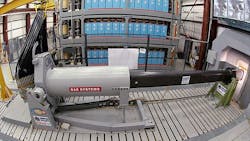BAE Systems to continue development of shipboard power for Navy's electromagnetic railgun
Officials of the Naval Sea Systems Command in Washington announced plans Friday to award a sole source contract modification to the BAE Systems Platforms & Services segment in Minneapolis to increase the level of effort on developing the electromagnetic railgun pulse-power system for completion later this year.
This future shipboard weapon will use magnetic fields created by high electrical currents accelerate a sliding metal conductor between two rails to launch projectiles at 4,500 miles per hour -- or nearly six times the speed of sound.
BAE systems also will work on integrating batteries and containers aboard surface warships that will host the electromagnetic railgun, as well as provide modeling and designs for shipboard pulsed power. The value of the upcoming order has yet to be negotiated.
BAE Systems Platforms & Services has been developing a pulse power unit for the Navy electromagnetic railgun since late 2011. As such, BAE Systems is the only responsible source able to develop the railgun's pulse power without causing significant delays, Navy officials say.
The Navy's electronic railgun will use massive amounts of electricity, so the project is pushing the state of the art in power generation and control.
The railgun will use electricity generated by its host ship that is stored over several seconds in the pulsed power system. The weapon sends an electric pulse to the railgun to create an electromagnetic force accelerating the projectile to speeds as fast as Mach 6.
The weapons is designed to destroy targets with kinetic energy, rather than explosives. It would eliminate the hazards of high explosives in the ship and unexploded ordnance on the battlefield, Navy officials say.
In 2012 BAE Systems demonstrated a 32-megajoule prototype at the Naval Surface Warfare Center in Dahlgren, Va. When fully developed, the railgun will provide increased velocity and extended range over traditional shipboard weapons.
The new weapon will be able to conduct precise, long-range naval surface fire support for land strikes; ship self-defense against cruise and ballistic missiles; and surface warfare to deter enemy vessels.
Related: Navy chooses L-3 to develop energy storage technologies for electromagnetic railgun
The Navy’s near-term goal is a 20- to 32-megajoule weapon that shoots a distance of 50 to 100 nautical miles. Navy officials want a rate of fire for the electromagnetic railgun of at least 10 rounds per minute. The pulsed power system will provide the electrical power necessary for this rate of fire.
In addition to BAE Systems, General Atomics in San Diego has been involved in developing a launcher and pulsed power system for the electromagnetic railgun.
L-3 Applied Technologies in San Leandro, Calif., is developing energy storage technologies for the electromagnetic railgun pulsed power system. Saft America Inc. in Cockeysville, Md., also developing non-propagating energy storage modules for the future electromagnetic railgun.
For more information contact BAE Systems Platforms & Services online at www.baesystems.com, or Naval Sea Systems Command at www.navsea.navy.mil.
Learn more: search the Aerospace & Defense Buyer's Guide for companies, new products, press releases, and videos
